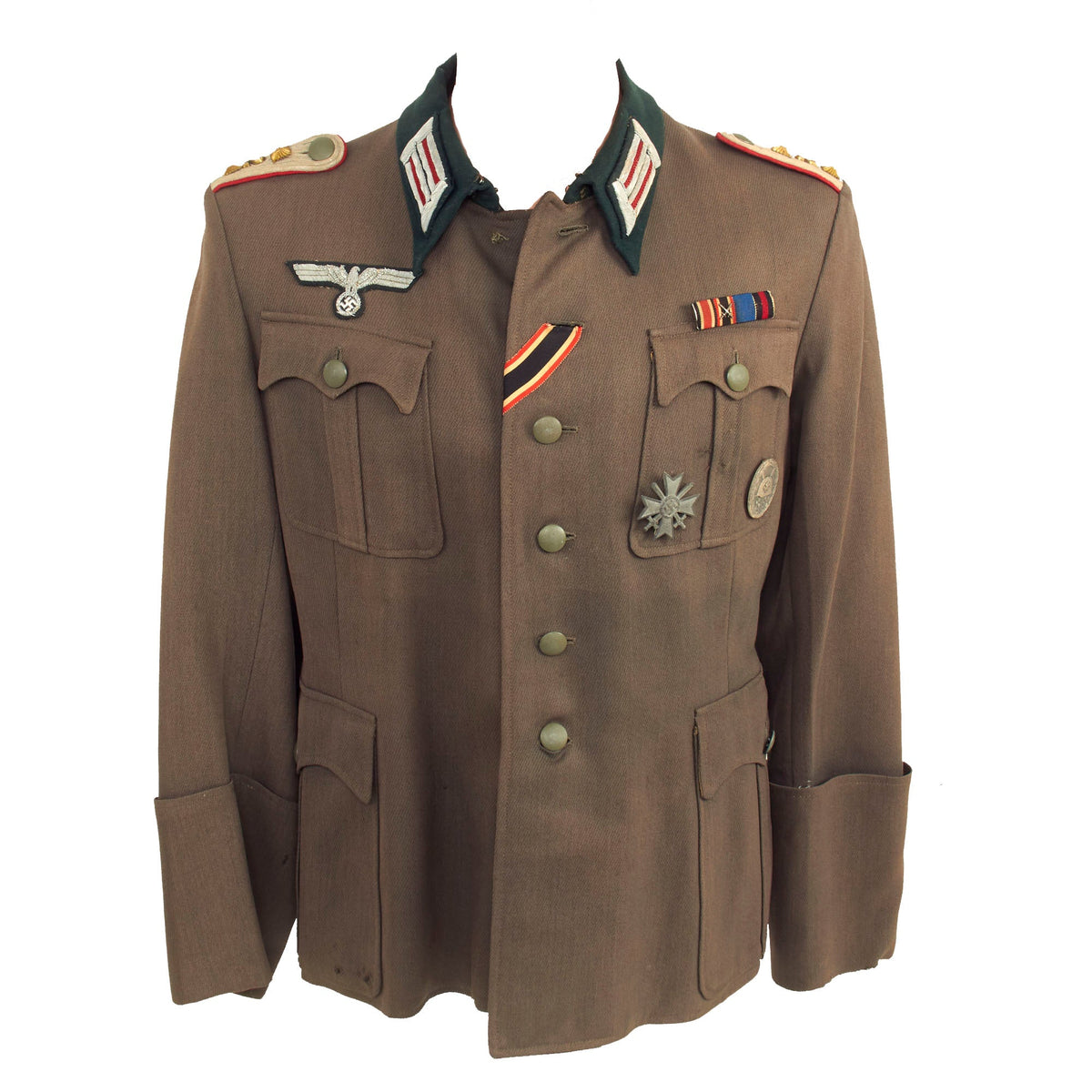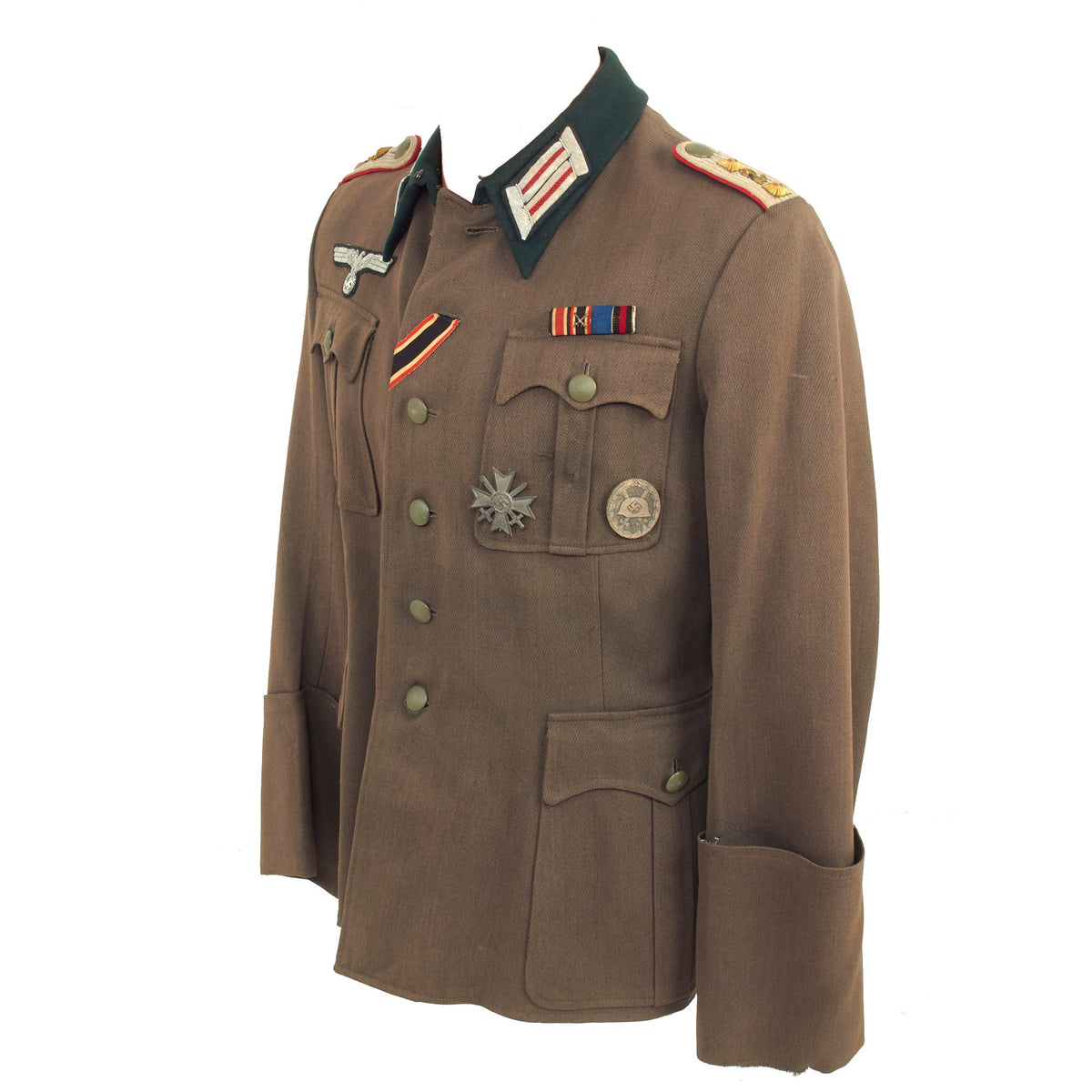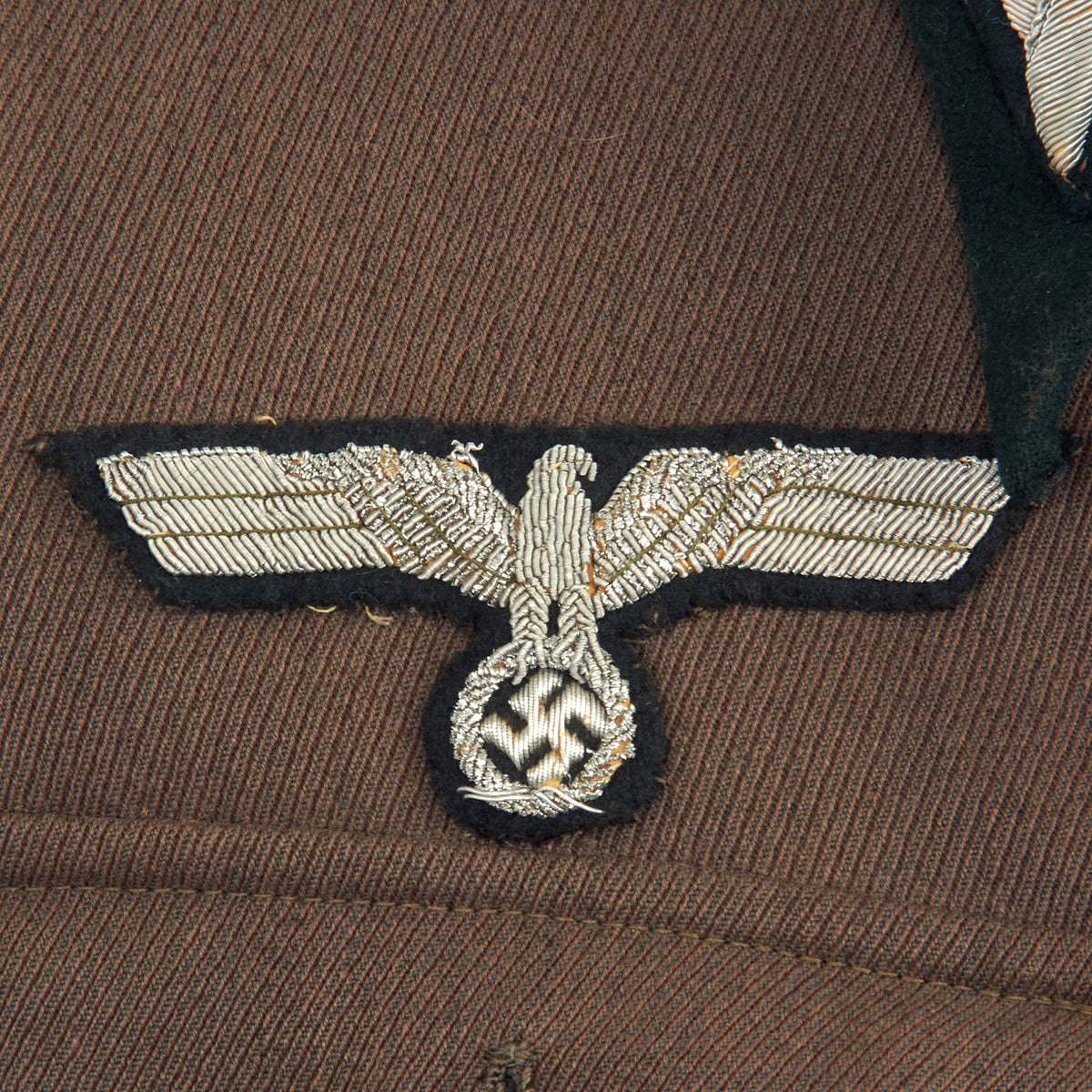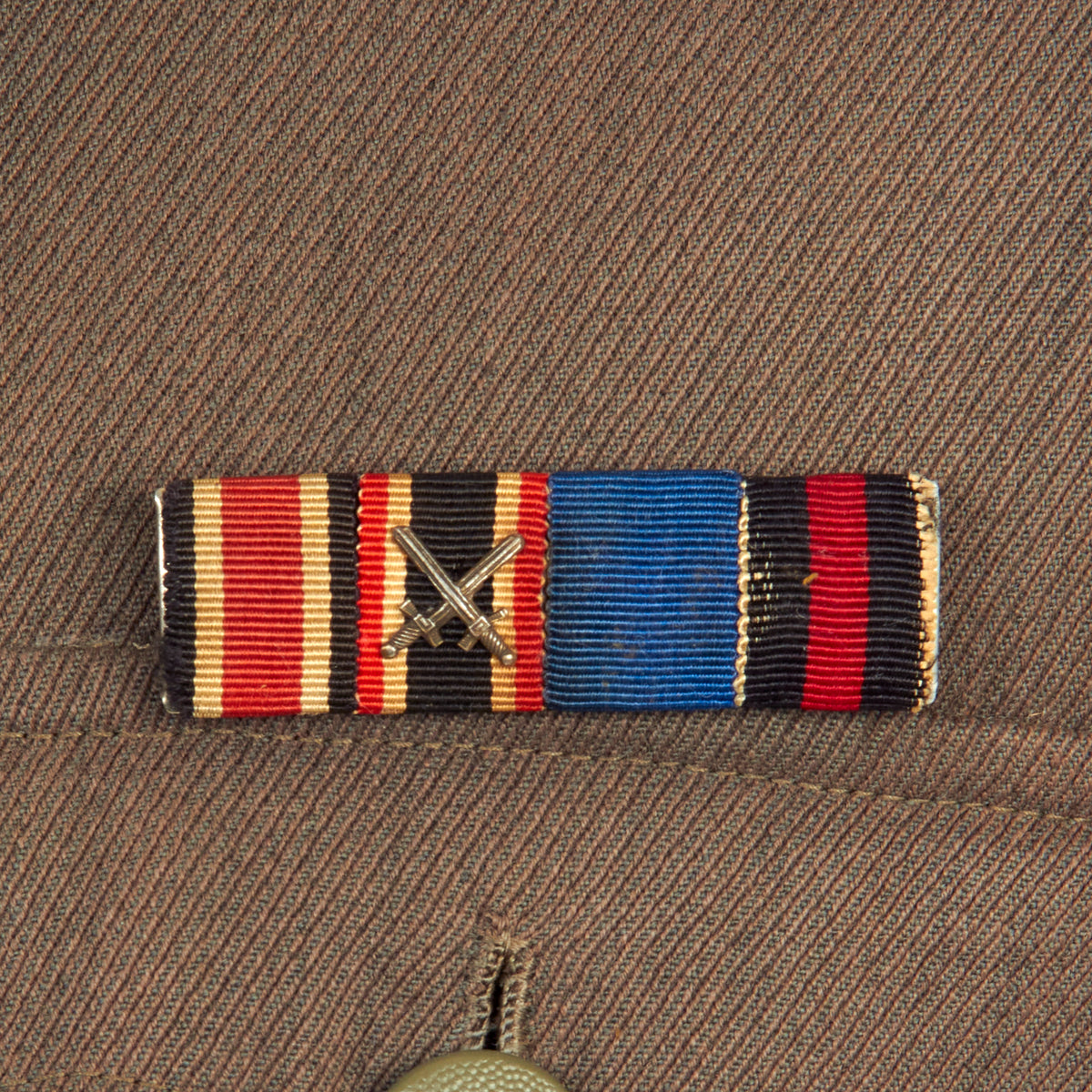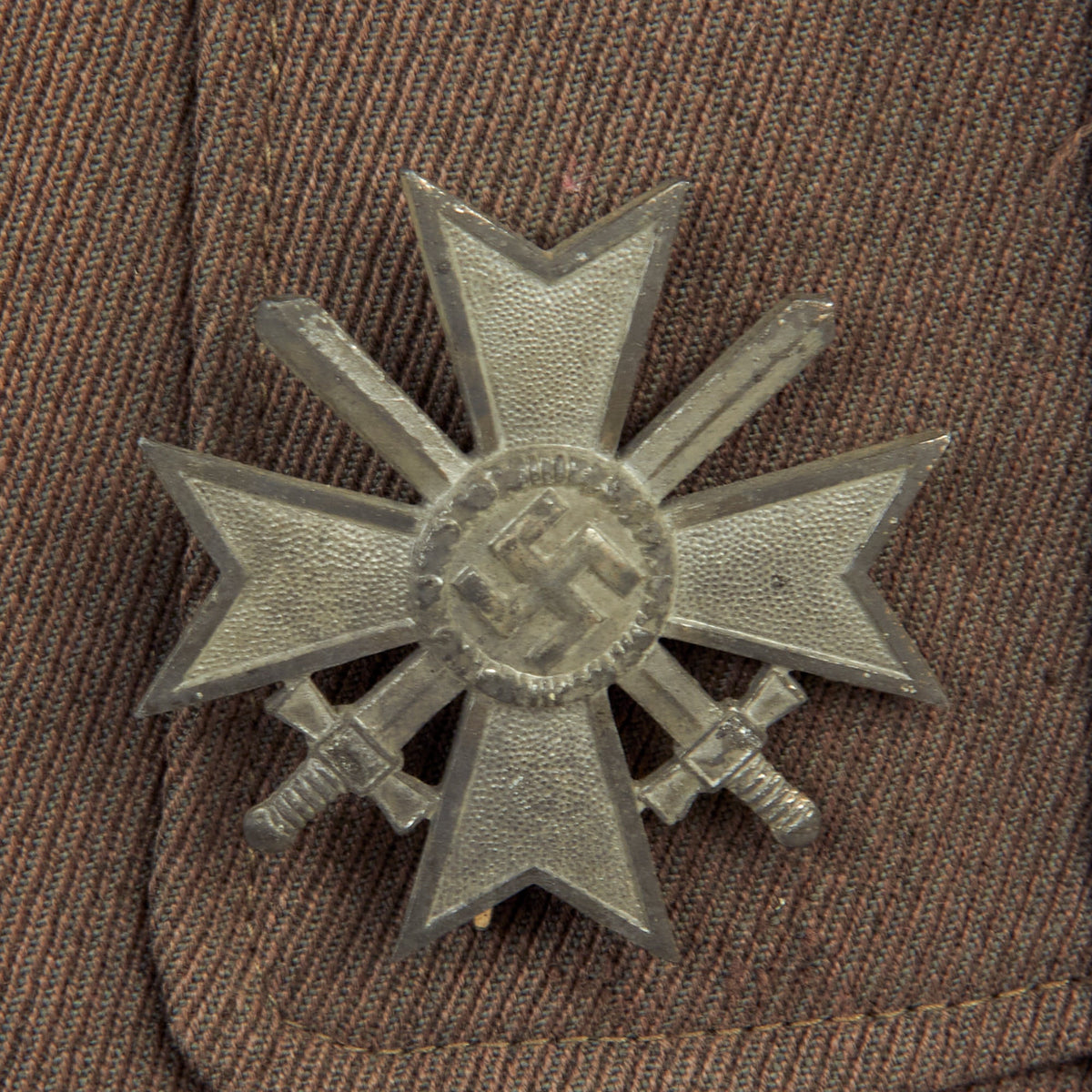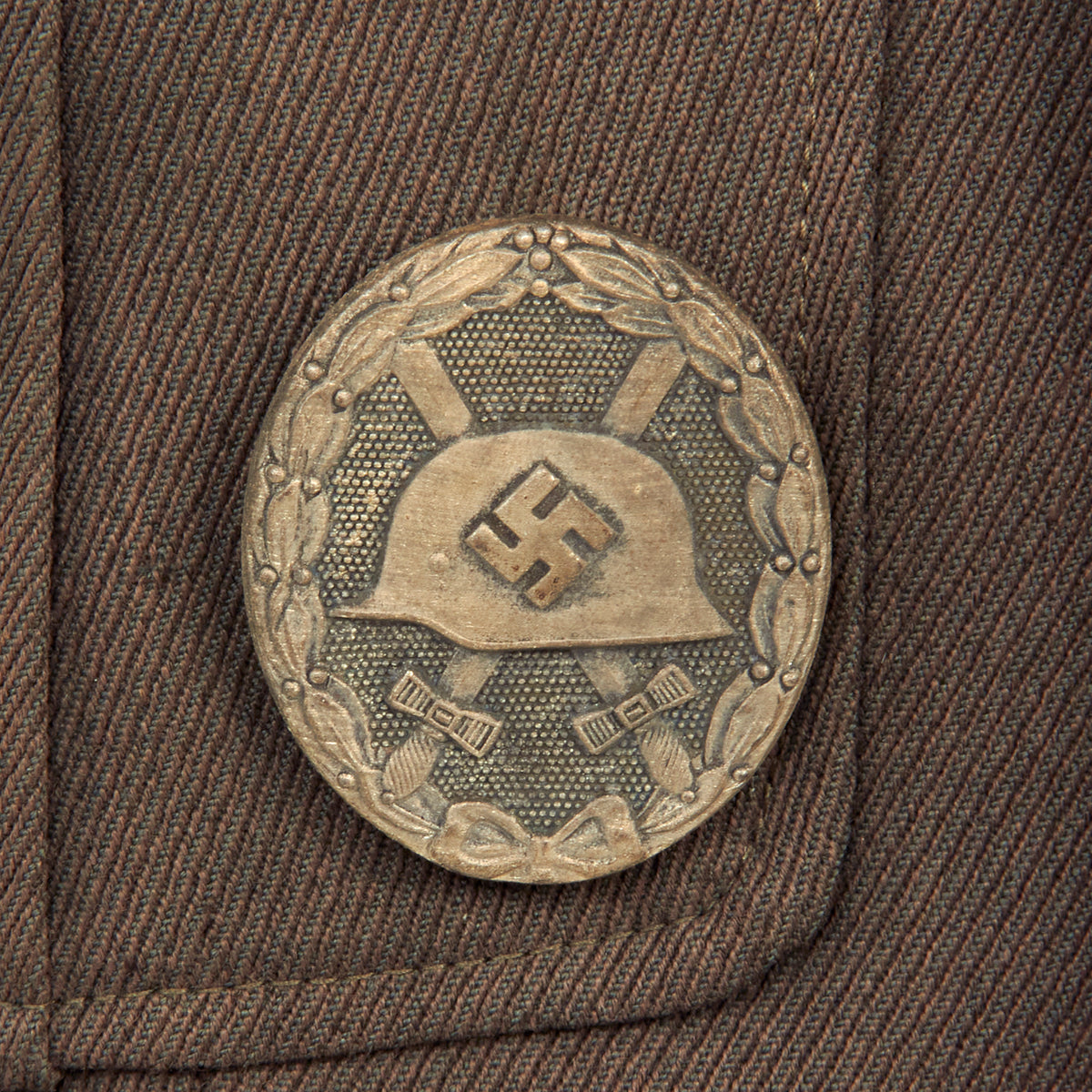Original German WWII Heer Artillery Hauptmann Officer’s M36 Field Tunic with Medal Bar, KVKI, and Silver Wound Badge Original Items
$ 1.895,00 $ 473,75
Original Item: Only One Available. This is a very nice early pattern German WWII Heer Army M-36 Tunic, showing moderate wear from service and in very good display condition. There is no maker mark on the interior, or other markings, so this was most likely custom made for the officer at a local tailor. The “whipcord weave” wool is more of a gray color than seen on later examples, and this looks to be typical of pre-war examples. The tunic features four pockets with scalloped flaps and green painted pebbled aluminum buttons, and has a six button front closure (one button missing), with two “hook and loop” fasteners for the collar. The buttons on the tunic are sewn directly to the fabric, not attached with metal circlips, and all show at least minor wear to the paint. One of the buttons is held in place by a safety pin, while another is attached to an alligator clip on the back of the uniform. All look to have maker marks on the back.
The interior is fully lined in olive green rayon with white striped sleeves, and the underside of the pocket flaps are lined with the same rayon material. There is some fading to the color on the underside of the flaps, and also on the back of the tunic inside the neck area. There is a nice hanger clip for a dagger installed, with a clip by F.W. Assmann.
The tunic is adorned with the usual rank and branch insignia used on German tunics. The attractive Army breast eagle is the correct officer’s silver bullion hand embroidered type on a green background, and is very neatly hand stitched to the chest in a fashion typical of wartime German tailor work. It is only stitched to the outer layer of fabric, indicating installation when the uniform was made, so it has never been replaced.
The collar is wrapped in a dark-green wool, has officer’s field litzen collar patches on each side, which are woven from silver bullion thread with a dark green background matching the collar. The colored stripes on each are Hochrot (Deep Red) wool, the Waffenfarbe (Corps Color) during WWII for Artillery, as well as General Level Officers. As this is a company grade officer tunic, this is definitely for artillery. The collar is in good shape, though there is a bit of wear around the edges, which is usually one of the first places to show damage from use.
The “sew-in” style company officers schulterklappen (shoulder boards) of this tunic are constructed with two rows of fine silver flatware “Russia Braid” double piping and have the correct red piping around the edges. There are two rank “pips” installed, indicating the officer rank of Hauptmann (Head Man), equivalent to a U.S. Army Captain. There is also a metal unit number 2 between the pips, which would probably represent the 2nd Artillery Regiment, or something similar.
Above the left pocket is a four award medal bar, showing that the soldier received the Iron Cross 1939 2nd Class EKII, the War Merit Cross with Swords KVK, Wehrmacht Heer 4 Year Long Service Award, and the Eastern Front Medal. Below this on the pocket are two awards still attached, as well as indications of another award that was removed at some point. There is also an EKII 1939 ribbon installed on the second button hole from the top.
On the right side is a wonderful War Merit Cross KvK 1st Class with swords (Kriegsverdienstkreuz 1. Klasse mit Schwerten) with Swords, marked on the back with Präsidialkanzlei des Führers Lieferant (Presidential Chancellery Supplier) number 3. This is the number assigned to Wilhelm Deumer of Lüdenscheid, a city with a very large garment accessories industry. On the left is a very nice Verwundetenabzeichen in Silber (Wound Badge in Silver – 2nd Grade) marked on the back with Lieferant number 65, for Klein & Quenzer A.G. of Idar-Oberstein.
Overall condition is very good, with just a bit of light wear and staining consistent with service. There is a bit of light mothing in areas, but nothing major, and most damage we can see looks to be from wear and use.
This is a uniform tunic that that saw some real service, and overall it displays very nicely, especially with the included awards and medal bar. Ready to display!
Approximate Measurements:
Collar to shoulder: 9.5″
Shoulder to sleeve: 24”
Shoulder to shoulder: 16.5”
Chest width: 18″
Waist width: 17″
Hip width: 19”
Front length: 28″
Terms such as M40 and M43 were never designated by the Wehrmacht, but are names given to the different versions of the Model 1936 field tunic by modern collectors, to discern between variations, as the M36 was steadily simplified and tweaked due to production time problems and combat experience.
Field Tunic (Feldbluse) Model 1936
When the NSDAP came to power in early 1933 the Reichswehr, the armed forces of the Weimar Republic, were near the end of a two-year project to redesign the Army Feldbluse (field-blouse). Beginning in that year the new tunic was issued to the Reichsheer and then the rapidly growing Wehrmacht Heer, although minor design changes continued to be made until the appearance of the standardized Heeres Dienstanzug Modell 1936. The M36 tunic still retained the traditional Imperial and Reichswehr uniform color of grey-green “field gray” (feldgrau) wool, but incorporated four front patch pockets with scalloped flaps and pleats (on Reichswehr tunics the lower pockets were internal and angled). The front was closed with five buttons rather than the previous eight, and the collar and shoulder straps were of a dark bottle-green instead of the Reichswehr grey. Compared to the Weimar-era uniforms the skirt of the feldbluse was shorter and the tailoring was more form-fitting due to Germany’s adoption of mechanized warfare: soldiers now spent much time in the confined space of a vehicle and a shorter jacket was less likely to pick up dirt from the seats. It also included an internal suspension system, whereby a soldier could hang an equipment belt on a series of hooks outside of the tunic. These hooks were connected to two straps inside the lining, which spread the weight of equipment without having to use external equipment suspenders. The M36 was produced and issued until the very end of the war, though successive patterns became predominant.
SS field uniforms were of similar appearance externally but to fit their larger patches had a wider, feldgrau collar, and the lower pockets were of an angled slash type similar to the black or grey SS service-dress. The second button of an SS Feldbluse was positioned somewhat lower, so that it could be worn open-collar with a necktie. Due to supply problems the SS were often issued army uniforms.
Fast Shipping with Professional Packaging
Thanks to our longstanding association with UPS FedEx DHL, and other major international carriers, we are able to provide a range of shipping options. Our warehouse staff is expertly trained and will wrap your products according to our exact and precise specifications. Prior to shipping, your goods will be thoroughly examined and securely secured. We ship to thousands clients each day across multiple countries. This shows how we're dedicated to be the largest retailer on the internet. Warehouses and distribution centres can be located throughout Europe as well as the USA.
Note: Orders with more than one item will be assigned a processing date depending on the item.
Before shipping before shipping, we'll conduct a thorough inspection of the items you have ordered. Today, the majority of orders will be delivered within 48 hours. The delivery time will be between 3-7 days.
Returns
The stock is dynamic and we cannot completely manage it because multiple stakeholders are involved, including our factory and warehouse. So the actual stock may alter at any time. It's possible that you may not receive your order once the order has been made.
Our policy is valid for a period of 30 days. If you don't receive the product within 30 days, we are not able to issue a refund or an exchange.
You can only return an item if it is unused and in the same state as the day you received it. You must have the item in its original packaging.
Related products
Uncategorized
Uncategorized
Uncategorized
Uncategorized
Band of Brothers ORIGINAL GERMAN WWII Le. F.H. 18 10.5cm ARTILLERY PIECE Original Items
Uncategorized
Uncategorized
Uncategorized
Uncategorized
Armored Burgonet Helmet & Polearm from Scottish Castle Leith Hall Circa 1700 Original Items
Uncategorized
Armoured Fighting Vehicles of the World: AFVs of World War One (Hardcover Book) New Made Items
Uncategorized
Uncategorized
Uncategorized
Uncategorized
Uncategorized
Uncategorized
Uncategorized
Uncategorized
Uncategorized
Angolan Rebel 1970s era 60mm Inert Display Mortar from Angolan Civil War Original Items
Uncategorized
